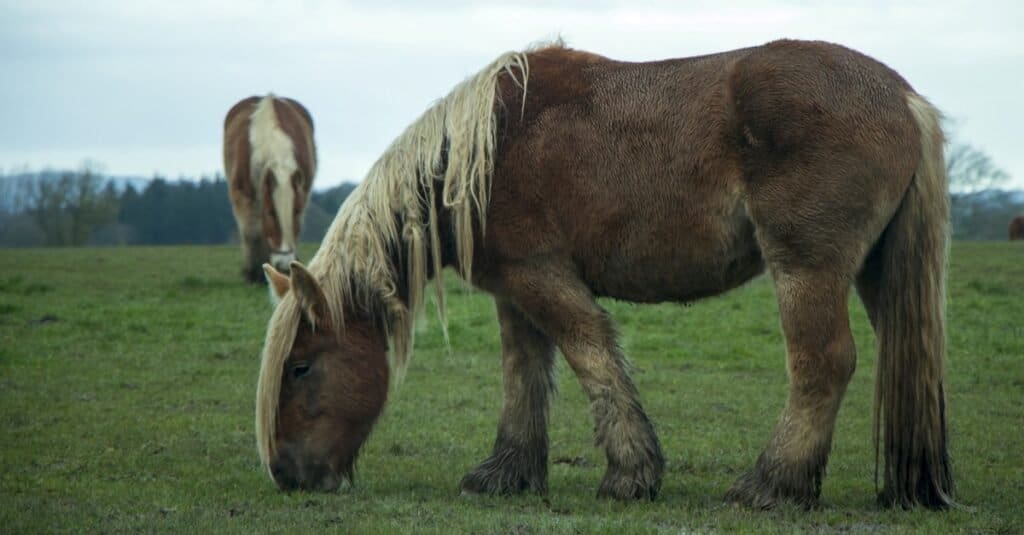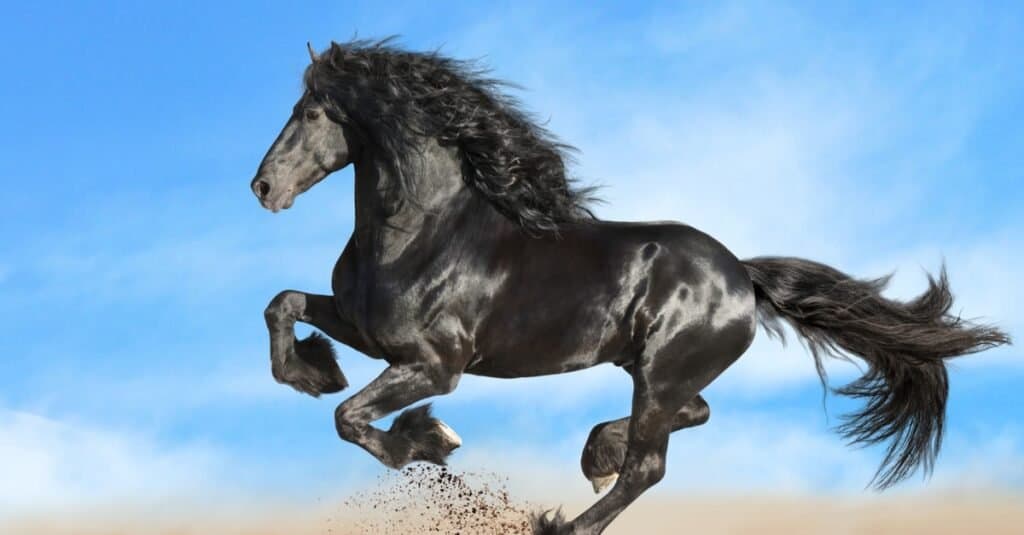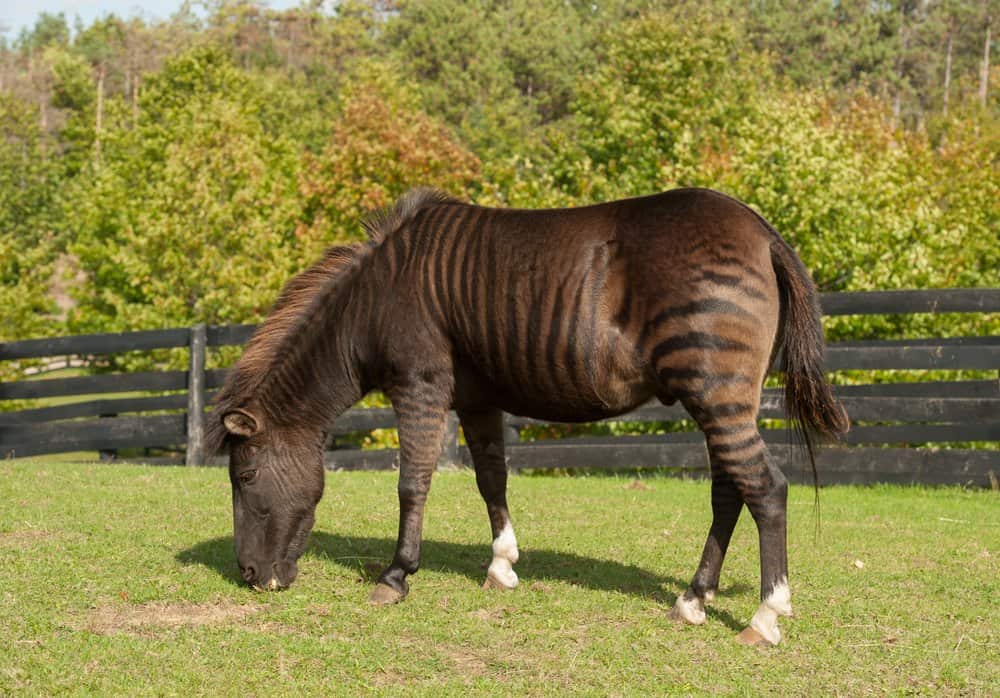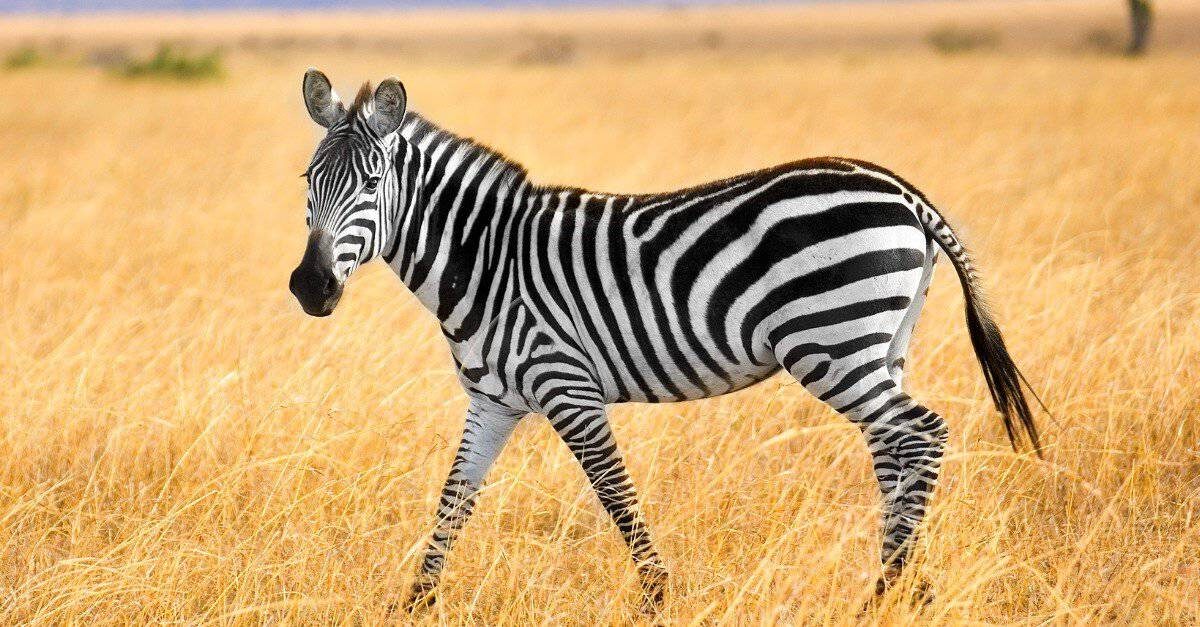Zebras and horses are two similar-looking quadrupeds that come from the Genus Equus. Both creatures are known for their beauty, herd behavior, and immense speed on open ground. Although zebras and some breeds of horses live across parts of Africa and are related to one another, they also have many distinctions. We’re going to answer the question, what are the differences between a zebra vs horse?
Take a look at how to tell apart these two equine animals. We’ll show you visual cues that differentiate them along with some less-obvious discrepancies between them.
Comparing a Zebra and a Horse

| Zebra | Horse | |
| Size | Weight: 480lbs to 900lbs Height: 3.8ft to 5.25ft Length: 7ft-9ft | Weight: 600lbs to 1,200lbs Height: 5ft to over 7ft Length: 8ft |
| Speed | 35-40 mph | 30-55 mph depending on breed |
| Personality | Difficult to tame and more aggressive than skittish | Most horse breeds are capable of being tamed, and they’re more skittish than aggressive |
| Coloration | White and black coats with alternating vertical stripes and patterns serve as a defense against predators | Fur comes in various colors and patterns but no clear camouflage against predators. |
| Manes | Thick, short, scruffy hair that grows straight out | Long, flowing manes that grow several inches in length and lay upon their necks |
| Ear length | Long, rounded ears similar to those on a donkey | Shorter ears that stand up straight and are more angular than rounded. |
The 6 Key Differences Between Zebra vs Horse

Horses differ from zebras in terms of size, speed, and colors.
©OlesyaNickolaeva/Shutterstock.com
The greatest differences between a zebra and a horse are their size, speed, and coloration. Zebras are smaller and lighter than horses, but they can exceed them in length. Zebras are also slower than horses in the majority of cases, but they are fast animals in their own respect.
Zebras have white and black coats of fur that alternate colors in vertical stripes that go down the length of their bodies. Horses usually have a single color in their coat, but some exceptions exist, like the Paint Horse and Appaloosa. Even then, horses don’t have a specific coat of stripes or camouflage.
Zebra vs Horse: Size

Some horses can stand almost two feet taller than zebras.
©Mads Hjorth Jakobsen/Shutterstock.com
Zebras are smaller than horses and they weigh less than them. Most zebras stand between 3.8ft and 5.25ft tall, and they grow up to 9ft in length. Horses can stand between 5ft and 7ft tall at their utmost, and they grow to a length of about 8ft. Thus, horses are larger than zebras, but zebras can be longer than horses.
Horses weigh between 600lbs and 1,200lbs, and zebras max out their weight at roughly 900lbs. Overall, horses are larger and heavier than zebras.
Zebra vs Horse: Speed
Zebras can run at a top speed of 40mph, but horses can run even faster, hitting a maximum speed of 55mph. Zebras are very swift because they need to run from some of the most dangerous predators in the world, including lions and cheetahs. Zebras are fast and agile.
Horses are also very fast, typically running between 30 mph and 45mph. However, the fastest horse on record managed to reach 55 mph, so it’s safe to say that horses are faster than zebras. Of course, zebras have not been bred for their speed for generations like horses.
Zebra vs Horse: Personality
Zebras are more aggressive and stubborn than horses. Aside from their size and back shapes, humans don’t ride zebras very often because they are incredibly hard to tame. Again, humans have been domesticating horses for thousands of years, so we don’t know if they were originally as hard to tame or as mean as zebras.
Nevertheless, most horse breeds are much calmer than zebras if they have been bred in captivity, but wild horses still exist and they’re very skittish and frightened more than they are violent.
The reason for this violence could be that zebras come from a place where they can escape some but not all threats. If something gets too close to them, that means they must take a stand in hopes of surviving, driving them into a fight-or-flight mode.
Zebra vs Horse: Coloration

Zebras’ striped fur can make it hard for predators to pick out one from the herd.
©GUDKOV ANDREY/Shutterstock.com
Zebras have a camouflage fur coat that consists of vertical white and black stripes running the length of their bodies. Horses’ fur comes in many colors, but most breeds have a one or two-color coat that lacks the distinct pattern seen in zebras.
Zebras striped patterns can serve as a deterrent for bugs, and it’s believed to have a camouflage effect against mammalian predators. When they see a herd of zebras running, the striped pattern apparently makes it hard for them to pick out a single creature from the crowd. That could offer some protection to their young or make it too confusing to home in on one zebra.
Either way, zebras have camouflage and horses do not.
Zebra vs Horse: Manes

Horses have long, thick, and flowing manes of hair as opposed to the thick, bristly zebra manes.
©Makarova Viktoria/Shutterstock.com
Zebra manes are thick, scruffy, and grow straight outward, but horse manes are long, thick, and flowy. The zebra’s mane will stand straight off its neck and have a bristle-like feel to it. Horse manes can grow several inches long and rest upon their necks like a human’s hair.
Zebra vs Horse: Ear Length
Zebras have longer ears than horses. The ears of a zebra are similar to those of a donkey in that they are both long and rounded. Horse ears are shorter and more angular than a zebra’s.
Can Zebras and Horses Interbreed?

The zorse can take on characteristics from both parents.
©Shawn Hamilton/Shutterstock.com
Yes, zebra and horse hybrids can occur when a zebra stallion impregnates a mare, and the resulting animal is called a zorse. Likewise, they are called an “hebra” when the reverse pairing occurs.
These animals can breed together in the wild, but it’s exceptionally rare. Many of the zorses that are known today are kept in captivity. They tend to have a mix of traits from their parents, including unique colorations in the striped pattern!
Zebras and horses are similar in many respects and related to one another on the grand scale of their Genus. However, they are different in many ways, too. They differ in size, speed, coloration, and more.
These animals vary in many obvious physical traits, but they also have some unique elements that can only be observed through careful study. The zebra’s personality is one example of a trait that requires a more in-depth look than the animals’ manes.
That is not the only non-physical difference between the creatures, of course. However, we have provided you with an overview that will help you identify the surface-level differences between these amazing animals.
Thank you for reading! Have some feedback for us? Contact the AZ Animals editorial team.








